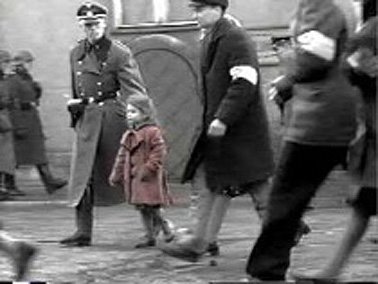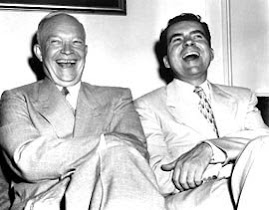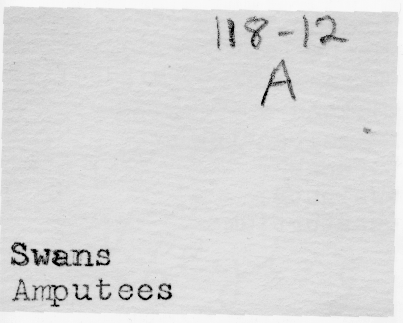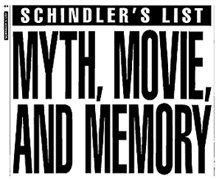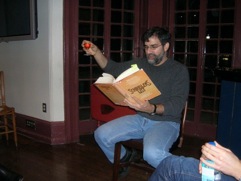 Zalman was born in Warsaw in 1927 as the only child of Izaak and Haja Akerman. Before marrying Zalman's father, Haja's name as Haja Filreis. I believe that Haja was a sister of my father's father--my grandfather--Ben. That would make Zalman my father's first cousin. Ben and his brother left Warsaw to come to Brooklyn in the 1910s, so the family was permanently split up even before World War II.
Zalman was born in Warsaw in 1927 as the only child of Izaak and Haja Akerman. Before marrying Zalman's father, Haja's name as Haja Filreis. I believe that Haja was a sister of my father's father--my grandfather--Ben. That would make Zalman my father's first cousin. Ben and his brother left Warsaw to come to Brooklyn in the 1910s, so the family was permanently split up even before World War II.He calls himself the only survivor of his family. But now, finally, he knows that other Filreises survived.
Zalman's father Izaak was a hat-maker who specialized mainly in leather hats. His mother Haja--formerly Haja Filreis--was a senior nurse in one of the hospitals of Warsaw. Zalman who was an only child studied at the Polish School on Ptasia Street.
As you will see, if you read on, Zalman is a survivor of the Holocaust. He was involved with the Warsaw Ghetto Uprising fairly far into that battle. The rest of his story is told through a web site called "Virtual Stetl," an attempt by some people in Israel to record the memories of Eastern European Jews who eventually found their way to the middle east.
"I had a happy childhood", says Zalman, yet he remembers very little from his childhood days and from his parents. "All what happened before the war was almost entirely erased, except for a few remembrances". For instance, Zalman remembers a colored painting of him when he was four, painted on canvas, which was hanging on the wall in their living room. From the house he remembers the opening sofa in the living room and the round table, which stood in the middle. The cooking stove in the kitchen, which was heated by fire-woods, and the portable stove from cast iron. One of the rooms served as a workshop for his father Izaak, including special models which Izaak sewed his hats on them.
His grandmother (on his mother's side) lived together with their small family and took care of the household and of Zalman, since his mother was working at the hospital.
"I don't remember the face of my mother clearly. What I picture in my mind is her image dressed in the white uniform of a nurse," Zalman sums up his vague memories of that period.
"My Holocaust started when I was 12", relates Zalman. "On September 1st, 1939, the Germans bombed Warsaw. A bomb fell on our house and miraculously we were saved. We were put in a ghetto. One day, during one of the actions, the Germans caught me and I found myself, together with several dozens of other Jews, marching towards the Umschlagplatz - the place from where the Warsaw Jews were sent to extermination camps. We waited for the train inside a large building. When the sign was given, we were ordered to march towards the train, escorted by armed Ukrainian soldiers.
Then one minute I ran away. I hid under a pile of feathers in a garage nearby. When the Germans entered the garage - I held my breath so that no feather would fly.
At night I left my hide-out and returned to the ghetto".
On April 1943, the Jews' uprising in ghetto Warsaw broke out. All the ghetto residents went down to the underground bunkers. Zalman and his mother stayed in one of the largest bunkers in the ghetto, on 22 Franciszkańska Street (his father Izaak was taken away and sent to extermination already in 1942).
On April 20th, the fighters were given an ultimatum to put down their weapons till 10.00 o'clock in the morning. The Waffen SS forces, which arrived at the place faced strong resistance. At that stage, the Germans began setting the ghetto houses on fire. When the fighters fled from the upper burning floors to the underground bunkers, the fire from above took all the supply of oxygen down below and turned the bunkers into suffocation traps. The Germans pumped poisonous gases into the sewage canals and the Jews who had to leave their hide-out were shot dead.
Zalman and his mother were caught and sent by train to one of the extermination camps. Zalman jumped off the train and ran away and since then he never saw his mother who continued her way by train till her bitter end.
Zalman wandered among the villages. He looked for partisans in order to join them and continue fighting the Germans, but he didn't find any and since he was afraid of being handed over to the Germans by the local peasants, he decided to return to Warsaw. He was captured again, and again found himself on a cargo train, this time on the way to Majdanek.
After several months in Majdanek, Zalman was sent to several concentration and forced labor camps. He prefers to avoid the details of those hard experiences he went through in that road of torment and he just sums them up in a few words: "It was very hard !!!"
Zalman was liberated by the American Army in Gedburg, Germany, wherein he arrived with the death march. After his liberation, when Zalman was eighteen he returned to Warsaw, but didn't find any family relative of his. He turned for help to the Jewish Committee in Warsaw, among whom the leaders of the ghetto Warsaw uprising, Izaak Zukerman and Cywia Lubetkin, were active. They sent him to the “Dror” Zionist youth movement. Zalman joined the Kibbutz of the movement (a group of youngsters who were preparing themselves for immigration to Israel and settling down there in a kibbutz). During their training, Zalman was sent to a seminar for youth instructors and for two years he was training children who were Holocaust survivors, most of them were orphans. "That work left in me a deep sense of responsibility towards the children and gave me great satisfaction. That period actually influenced my entire life", says Zalman. On April 1947, he sailed together with a group of 43 children, from Marseille, France to Israel (which was then still Palestine), on board the ship "Theodor Herzel". But when they reached the coasts of the country, the British Mandate authorities prevented their ship from anchoring in Haifa and they were driven away to Cyprus.
They were released at the end of 1947 and left Cyprus and arriving in the land of Israel. The children were sent to Kibbutz Beit Hashita while Zalman volunteered to the Palmach (the military force of the Hagana organization).
In the Independence War of Israel, Zalman enlisted to Battalion 6 of the Harel Brigade, where he served till the Palmach was dismantled and its fighters joined the Israeli Defense Forces.
"After the war ended and I was released from the army, I felt lonely and therefore the Kibbutz way of life seemed ideal for me", tells Zalman, "and choosing to join Kibbutz "Lohamei Hagethaot" seemed only natural. Many members of the "Dror" movement were there, and I knew some of them from the time I was activein the "Bricha" organization.
(The organization was established by the soldiers in the Jewish Brigade and the emissaries of "Aliya Beth" (Hebrew: the second immigration). The "Bricha" operated during '44-'49 to transfer Holocaust survivors from eastern Europe to western Europe and the coast, in order to bring them to Palestine. Survivors of youth movements, partisans and fighters from the ghettos also participated in the "Bricha" activities.)
Zalman continues: "Kibbutz" Lohamei Hagetaot" was founded in 1949, in the Western Galilee, by Holocaust survivors, partisans and fighters from different ghettoes. At the Kibbutz I was instructing immigrant youth".
There at the kibbutz he also met Sheila Feingold, a new immigrant from England. They married on May 3rd, 1953. Their first daughter, Amit, was born in 1956.
In 1959, Zalman and Sheila together with their daughter Amit moved to the youth village of Ben Shemen, where their second daughter Anat was born in 1962. In Ben Shemen he worked as a teacher in the Aliyat Hanoar immigrant youth movement. Sheila started working as an English teacher on Educational Television since it was founded in 1964, and continued working there for the next 32 years.
Zalman decided to complete his education, since he managed to study only six years before the war broke out. Although he was then already married and a father of two, he took his matriculation exams and along the years completed three university degrees in education. His doctorate work for his Ph.D Degree was about Janusz Korczakwho had interested him since he was a child. "Kortchak was my guide along my work in the educational field", he used to say. And so Zalman, who started as an unqualified teacher, ended his role in the educational system as a boarding schools’ inspector on behalf of the Ministry of Education.
Another passion of Zalman was theatre. Already in 1945, in Poland, he directed a theatre play about ghetto Warsaw, in front of an audience of Jewish survivors. In Israel, while he was a school director in the city of Ramle, he founded a puppet theatre. After his retirement Zalman founded a marionette theatre, "Bubonoa", which performed most successfully for six years all over the country and received the recognition of the Ministry of Education.
At the end of the 1990's, Zalman and Sheila moved to a Home for Retired people, called "Migdalei Hajam Hatichon" in Kefar Saba. Zalman received a studio from the house management, where he creates puppets from different materials (some of them are recycled) and also instructs a study group among the house members how to create marionettes. Each year the study group members present an exhibition of their own hand-made marionettes.
Yet Zalman declares, "The main thing in my life was and always remains my family". Indeed, as the only survivor of his family, all alone in the world, Zalman was fortunate to raise a wonderful family. Sheila and Zalman have seven grandchildren. Their eldest daughter Amit has four children: Yuval, Eyal, Razi and Dani. Their second born daughter Anat has three children: Guy, Omer and Ayelet.






 "I teach horizontally, meaning that while I might begin with a fixed idea of what I'm going to teach that day, I let it drift rhizomatically way off topic, often pulling it back when it gets too far. I rely on non-fixed materials to teach this way; the whole world is at my fingertips. Should I go off on a tangent about John and Rauschenberg and their love relationship as expressed in Rauschenberg's bed, an image of that bed is always a click away. From there, we can head anywhere into the non-fixed universe, be it film, text or sound. And of course, that always takes us elsewhere. As Cage says, 'We are getting nowhere fast.'"
"I teach horizontally, meaning that while I might begin with a fixed idea of what I'm going to teach that day, I let it drift rhizomatically way off topic, often pulling it back when it gets too far. I rely on non-fixed materials to teach this way; the whole world is at my fingertips. Should I go off on a tangent about John and Rauschenberg and their love relationship as expressed in Rauschenberg's bed, an image of that bed is always a click away. From there, we can head anywhere into the non-fixed universe, be it film, text or sound. And of course, that always takes us elsewhere. As Cage says, 'We are getting nowhere fast.'" 

 that anyone has yet got the imaginative measure of that terrifying day six years ago. Certainly our Tolstoy has not crawled out of the rubble. The closest we have, Don DeLillo, succeeded as an essayist-journalist ("In the Ruins of the Future: Reflections on Terror and Loss in the Shadow of September,” Harper’s, December 2001) but, to my mind, failed as a novelist ("Falling Man"). One reason, perhaps, is that the remembered emotion was instantly buried under a pile of cultural junk.' - Tod Gitlin in his review of Susan Faludi's The Terror Dream (written for
that anyone has yet got the imaginative measure of that terrifying day six years ago. Certainly our Tolstoy has not crawled out of the rubble. The closest we have, Don DeLillo, succeeded as an essayist-journalist ("In the Ruins of the Future: Reflections on Terror and Loss in the Shadow of September,” Harper’s, December 2001) but, to my mind, failed as a novelist ("Falling Man"). One reason, perhaps, is that the remembered emotion was instantly buried under a pile of cultural junk.' - Tod Gitlin in his review of Susan Faludi's The Terror Dream (written for 


